1960 DIVE
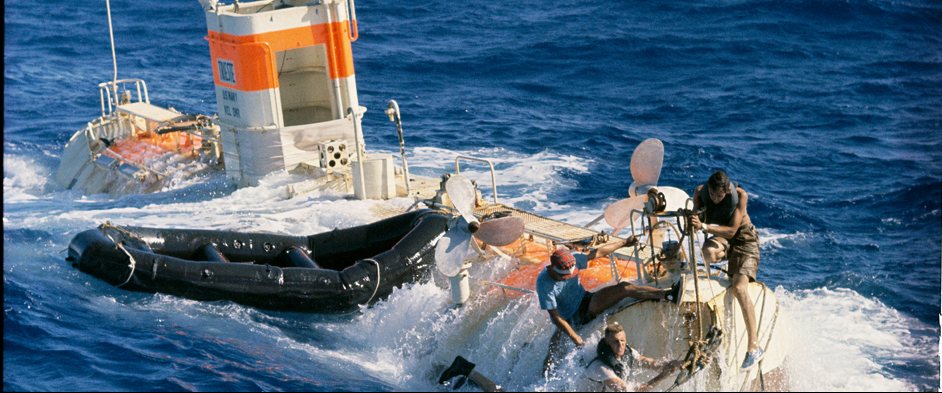
This article was originally published in the August 1960 issue of National Geographic magazine and retains the original language and spellings.
Man’s Deepest Dive
By Jacques Piccard
“Do you think we shall be able to make the dive?”
The voice of our faithful engineer, Giuseppe Buono, was taut with anxiety. A 37-year-old Italian, he had already prepared the Trieste for diving 64 times, first in the Mediterranean and this year in the western Pacific off Guam. Now he was wondering whether it was not sheer madness for the bathyscaph to attempt to descend 36,000 feet—nearly seven miles—under existing conditions. In fact, I was wondering the same thing myself.
The date was January 23, 1960. The United States Navy’s ocean-going tugboat Wandank had been towing the Trieste for four days; now we were some 220 miles from our base on Guam.
The sea had become rougher and rougher. At that moment waves were sweeping the bathyscaph’s deck without ceasing, and we had just discovered that the surface telephone, which enabled the pilot to give his final instructions before the dive, had been torn away. The tachometer, indicating speed of descent and ascent, had been completely demolished during the towing, though it rode eight feet above water level and had weathered more than 50 dives.
Another instrument, a vertical current meter, was partly broken and hanging miserably on its support. The bathyscaph looked like a victim of battle rather than an undersea laboratory about to explore the Mariana Trench—the deepest place in the oceans.
Torches Mark Scene of Dive
It was hardly daylight. A few dozen yards away on the water burned some flares which our escort destroyer had placed to show us the exact spot where the dive should begin. Indeed, the bottom had been carefully sounded. More than 800 TNT explosions had followed one another for two days before the Challenger Deep was marked.
All that work, those four days of laborious towing, the unavoidable fatigue that resulted for the crew—was it all to be lost? Should we risk months of delay because a few instruments—important, to be sure, but not vital—were lacking?
“I am going to check the main electric circuits in the sphere,” I replied to Buono. “Then, if everything is in order, we shall dive immediately.”
The main electric circuits control release of ballast. One of my father’s basic ideas when he invented the bathyscaph was to hold the ballast—in this case mainly iron pellets—by means of electromagnets. Hence it is necessary merely to cut the current, an operation that is always possible, in order to lighten the bathyscaph and cause it to ascend automatically. The bathyscaph functions like a balloon in the sea, deriving its buoyancy from lighter-than-water gasoline instead of the balloon’s lighter-than-air gas.
Don Walsh joined us on the bathyscaph’s deck. Lieutenant Walsh, the U. S. Navy officer in charge of the Trieste, had already made six dives, the latest to 24,000 feet with me two weeks previously.
This dive we were making was to be decisive for Don as well as for me: If everything went as planned, he would take over as the bathyscaph’s pilot, and I, having shown the Trieste‘s capabilities to the utmost, would return to Switzerland and set to work constructing a new machine.
In the sphere the air was good—fresh and dry, thanks to the silica gel placed on board before our departure from Guam. This does not mean we were comfortable. The big gasoline-filled float above our spherical cabin was the plaything of the waves, and the whole machine was rocking hard.
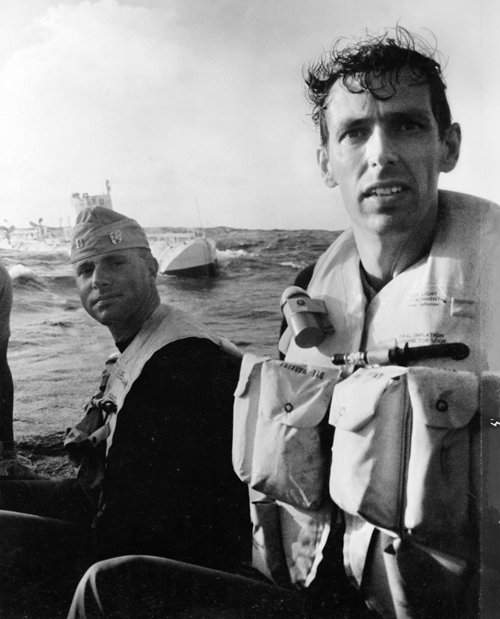
Under these conditions the foremost desire of a cabin passenger is to penetrate as quickly as possible into the depths, which alone can shield him from the rolling waves.
I hurry up the ladder onto the deck and give final instructions to Buono.
“When I have closed the door,” I tell him, “you may open the entrance-tube valves and proceed with normal operations. If, at the last moment, something doesn’t go well, I shall turn the propellers, and you will know that we must give up the dive.”
This simple code is to take the place of the surface telephone, destroyed by the sea during the towing. From the cabin I can turn the propellers, located on deck in Buono’s sight, and halt operations if something goes wrong—for example, in the unlikely event of water entering the cabin through an improperly shut hatch.
As soon as the bathyscaph is entirely under water, the undersea telephone will go into action, and contact will be established with our friends on the surface.
Definitely the sea is not calming down. It is broad daylight now. A few hundred yards away the Wandank is rolling and pitching more than ever. Having released the bathyscaph, she now seems to be at loose ends.
A little farther away I see the Lewis, disappearing entirely every few moments behind the big waves. She is the destroyer escort assigned to assist us on the surface and to watch over the area during the dive.
Single Bolt Seals Bathyscaph Hatch
The sky is heavy, overcast. The weather is hot and humid. We are in the tropics, and the Trieste‘s deck is constantly swept by the waves.
The moment does not lend itself to meditation. I go down into the cabin again, and the heavy steel hatch that will protect us from the sea is carefully closed. Indeed, a single bolt is all that is needed to close it hermetically. At the bottom, nearly 3,000 tons of water will see that the hatch remains closed!
Through the rear porthole we see water rising in the entrance tube, by which we came into the cabin. During the dive, this tube must be filled with water. With compressed air we shall blow it out when we reach the surface after the dive, thus clearing the passage to the deck and the open air.
A few moments later, all apparent motion of the cabin ceases: The dive is beginning. It is 8:23 a.m.
The buffeting waves, by covering the Trieste, have sent it into a region of eternal calm, an immense mysterious domain where the fish of the deeps open their avid eyes in the darkness, and where chilly waters are found only a few thousand feet from the eternally warm seas of the tropics.*
With a sigh of relief Walsh and I welcome the beginning of the descent. We think with compassion of those who will remain on the surface during the nine hours the dive is to last. They will not, as we shall, enjoy a calm, almost beneficent, day. They will be a prey to wind and sea, and to anxiety also, for the news they will receive from us will be brief.
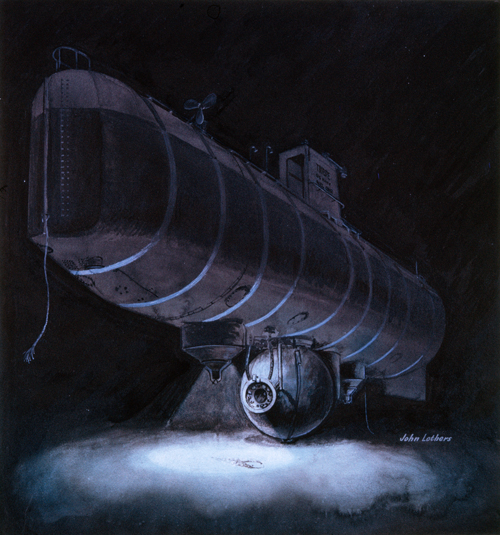
The beginning of the dive was extremely slow. The bathyscaph had been very well balanced, and the first minutes of calm and respite allowed us to complete the necessary checks to make sure everything was in order.
Ten minutes after leaving the surface, we were at a depth of only 300 feet. There the bathyscaph stopped of its own volition. We had reached a much colder layer of water, and the relative weight of the craft with respect to the water had suddenly diminished, bringing the descent to a halt.
Here already we faced a dilemma: We could wait until the gasoline of the float cooled enough to enable the bathyscaph to resume the descent; but then we would lose precious time, and it was absolutely necessary to surface before nightfall. The other course was to release some gasoline; but that would mean sacrificing at the very beginning of the dive some of the precious liquid needed to lift us back to the surface.
Gasoline Released to Speed Descent
I had confidence in the calculations that had established the ballast-gasoline ratio for this dive. These had shown that we could safely release even the whole of our expendable gasoline—150 cubic feet. The remainder—-more than 4,000 cubic feet—should be sufficient for our ascent.
I opened the gasoline valve, and a minute later the descent resumed. Another layer of cold water stopped the Trieste 35 feet farther down. I released a bit more gasoline. Five minutes later, at a depth of 425 feet, the Trieste came to a halt again. And again, seven minutes later, we stopped at a depth of 530 feet. This was the first time in my 65 dives in the Trieste that I had observed this phenomenon of repeated stratification.
At each of these stops Walsh watched very carefully a new electric thermometer that gave us the temperature of the water with great precision. In this way he was able to ascertain the very marked presence of what oceanographers call the thermocline. Each time, the bathyscaph rose and fell slightly, partly from the effects of internal waves.
After traversing about 650 feet at an average speed of four inches per second, the Trieste finally decided to embark seriously on this dive into the enormous depths.
Because the gasoline of the float is more compressible than water, the freely entering sea water continually increases the weight of the bathyscaph during the descent. Thus, unless the pilot takes a hand, the speed increases also until the bottom is reached. But the pilot watches the speed and releases ballast to keep within the limits of safety.
Already it was dark, and shortly afterward the first traces of phosphorescent plankton appeared. We scarcely used our searchlights during the descent, because we wanted to observe bioluminescence of undersea life as much as possible.** As it turned out, we saw luminescent trails only at 2,200 feet and at around 20,000 feet.
This immense column of water through which we were passing now at about three feet per second—the speed of an elderly elevator—seemed to me to be extraordinarily empty. However, the very passage of the bathyscaph inevitably disturbs the natural conditions of the sea and perhaps causes living creatures to flee. I have never been able to perceive fish during a rapid descent. Even when the descent is very slow, it is rare to observe living forms other than plankton, or relatively primitive species.
Before the dive I had decided to allow the Trieste to descend at about three feet per second to 26,000 feet, then to reduce the speed to about two feet per second down to 30,000, and from there to descend at about one foot per second. Thus we should have time to slow the bathyscaph when the bottom appeared on our sonic depth finder.
Although we assumed that there would not be any violent undersea current to sweep us far off course, there was, nevertheless, a possibility that we might come down on a slope of the trench instead of on the floor, landing sooner than planned and perhaps striking a hard surface, even rocks.
Measuring and adjusting the bathyscaph’s speed requires a constant check of the temperature of the water, the temperature of the gasoline, the amount of ballast released and the quantity still available, and, of course, the pressure and the exact time. In addition, it was advisable to check, among other things—and to note down regularly—the oxygen dosage. the percentage of carbon dioxide, the humidity, and the temperature inside the cabin. Thus our nearly five hours of descent did not seem long to us.
By a depth of 1,500 feet the darkness was total. Inside the cabin we had turned on only a small light, just sufficient for reading the instruments. The temperature of the water was falling, and the cabin began to feel cold.
“Say, Don, suppose we put on our dry clothing.”
Walsh looked at me somewhat doubtfully. Not a tall man, he can move about easily in the cabin, while I should have to open the port to stretch my arms. Yet I have dived so often that I feel perfectly at home. Besides, I had the cabin made with a diameter of six feet four inches—almost my height.
According to our program we were to remain nine hours in the cabin practically without moving, seated on small stools. It was wise to take all possible precautions against the cold that awaited us farther down. Warm clothes had been placed in the cabin, and it felt good to struggle into them, for we both had been drenched when we came aboard.
At 5,600 feet came a telephone call for me. An hour and a quarter had passed since the dive began. Thanks to an admirable apparatus built at the United States Navy Electronics Laboratory at San Diego, California, we had had sonic telephone contact with the surface from the outset. I asked Buono for information concerning final surface operations; he replied that everything had proceeded normally, in spite of the condition of the sea.
At 10,000 feet we had another good telephone conversation, this time with Lt. Lawrence Shumaker, then another at more than 13,000 feet. Walsh was at the telephone.
“Reception is still good,” he said to me. “Can we maintain contact all the way?”
“It is difficult to tell,” I replied. It would be necessary for the Wandank to remain almost vertically above us, not an easy operation in bad weather.
Up there on the surface, we know, the tugboat and the destroyer are keeping watch, a long fatiguing watch in the stormy sea, covered with great white crests as far as the horizon. Faithfully our friends far above watch the telephone, watch the radio, watch all around this mysterious point where a hundred pairs of eyes saw the Trieste swallowed up this morning. We know that up there—three miles above us—a whole surface team is ready to receive us when we ascend.
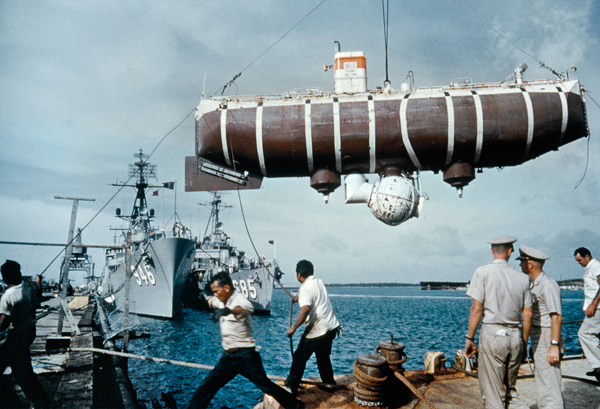
But for the moment we are going down. As we look through the porthole, we see passing, still at three feet per second, torrents of plankton-bearing water that seem to rise from the abyss as we approach the bottom. We pass successively those depths we reached during the preceding weeks: 18,600 feet, 24,000 feet.
“We are at a depth where no one has yet been,” murmurs Walsh. Silently I acquiesce.
For a moment my thoughts return to the past. For the fourth time the Trieste is penetrating into virgin depths: once in 1953, again in 1959, twice in 1960. The Trieste, built to take man to any depth, has served its masters well. But we are not yet on the bottom.
At a depth of 26,000 feet our telephone is still able to intercept a conversation between our tugboat and the escort destroyer!
It is 1130 hours; we are following our diving plan exactly. Now I reduce speed; we have already dropped six tons of ballast.
Outside the water is magnificently limpid—no trace of life, no plankton. Switched on for an instant, the searchlight casts its rays deep down beneath the bathyscaph; it seems as if nothing can stop this light. We are in the void, the void of the sea, which squeezes upon the wall of our sphere with nearly 150,000 tons.
Now we descend very slowly, about one foot per second. We have turned on the sonic depth finder, and from one moment to the next we expect to see the bottom appear. The searchlights are switched on again, and from time to time I let drop a little ballast. Time seems to move slowly.
Suddenly, at 32,500 feet, we are startled by a dull cracking sound from the bathyscaph. At the same moment a rather heavy shock makes the cabin tremble.
We look at each other.
“Have we touched bottom?” Walsh asks.
“I don’t think so; the depth finder hasn’t shown anything,” I reply.
No, the Trieste continues to descend slowly, regularly. The bottom is still invisible. What should we do? Could we have encountered an undersea monster? On board everything seems normal, no change in the equilibrium of the bathyscaph. We continue descending steadily.
For a few minutes we stop everything on board that makes a noise: oxygen passing through the injector, humming of electronic instruments, everything. In the heavy silence we hear only tiny crackling sounds, like ants in an ant hill, little cracking sounds coming from everywhere, as if the water were being shattered by our passage. Could it be shrimps? Is the cabin’s paint cracking? We do not know yet, but the descent itself is regular, reassuring.
“In my opinion,” I say, “it isn’t anything serious; we are not losing any gasoline. Let’s go on and we’ll see later.”
“O.K.,” Walsh replies laconically.
There are now a few traces of life in the water. I scarcely have time to observe them, but they seem to be jellyfish, very small. This is not a surprise, since we know that there is life, at least bacteria and even anemones, down to very great depths. The remaining question is whether there are fish.
We continue to descend, exceedingly slowly now. Our gasoline is still cooling, and, as more water enters the float because of the contraction of the gasoline, it makes us heavier and heavier. I feel as if these hundreds of gallons of water are passing into my veins.
The telephone has gone silent. We are perhaps too deep? The descent is silent, slow, and our eyes pass from porthole to depth finder, from depth finder to porthole. We are very near the bottom; we should reach it at any moment . . . but we continue to descend.
At 1256 hours I say to Walsh, “Don, look. Here is the bottom on the depth finder.”
“Finally,” Don replies.
Yes, finally—the bottom, quite distinct on the depth finder, 300 feet below us. Those 300 feet were traversed in 10 minutes; and at 1306 hours the Trieste, in my sixty-fifth dive, made a perfect landing on a carpet of uniform ivory color, that the sea had laid down during the course of thousands of years.
Fish Meets Sphere on Bottom
Like a free balloon on a windless day, indifferent to the almost 200,000 tons of water pressing on the cabin from all sides, balanced to within an ounce or so on its wire guide rope, slowly, surely, in the name of science and humanity, the Trieste took possession of the abyss, the last extreme on our earth that remained to be conquered.
And to demonstrate well all the significance of this dive, nature would have it that the Trieste come down on the bottom a few feet from a fish, a true fish, joined in its unknown world by this monster of steel and gasoline and a powerful beam of light. Our fish was the instantaneous reply (after years of work!) to a question that thousands of oceanographers had been asking themselves for decades.
Slowly, very slowly, this fish—apparently of the sole family, about a foot long and half as wide—moved away from us, swimming half in the bottom ooze, and disappeared into the black night, the eternal night which was its domain.
Slowly also (Is everything slow, then, at the bottom of the sea?), Walsh held out his hand to me.
We remained on the bottom for 20 minutes. We took temperature measurements (about 38° F.), made measurements of a possible undersea current (none, apparently), and of radioactivity (no positive indication), and spent several minutes at the porthole. Once a shrimp swam peacefully in front of us.
As a matter of duty and to leave nothing undone, Don skeptically called the surface on the telephone:
“This is Trieste on the bottom, Challenger Deep. Six three zero zero fathoms. Over.”
Suddenly I saw him give a start, and I was able to follow the telephone conversation.
“I hear you weakly but clearly. Please repeat the depth.”
Don did so slowly. “Everything O.K.” (What could go wrong?) “Six three zero zero fathoms?”
“That is Charley.” (In the seaman’s jargon, Charley stands for “C” and means “correct.”) “We will surface at 1700 hours,” Don replied.
“Roger.” (That is, “understood.”)
Of course we had every reason to be pleased with this telephone conversation. On the surface our friends were reassured as to our fate, but, in particular, we had been able to perform a highly interesting experiment. The credit belonged to scientists who, after long and patient laboratory research, had succeeded in giving us a telephone unparalleled in the world. With their instrument, without wires or radio waves, we had established the first voice communication between the surface and the great depths of the ocean.
If I had the space here, I could mention in greater detail the names of all those to whom credit is really due for this dive: first of all, Prof. Auguste Piccard, my father, with whom I have had the privilege of working for many years.***
He not only invented the bathyscaph and set down its whole theory, but also, after years of research and laboratory experiments, built and tried two models of it himself.
Credit should also go to nations: Belgium, which supplied the funds for the first bathyscaph; Switzerland and Italy, which did the same for the Trieste; West Germany, which built our third submarine cabin; and finally the United States, which took over our work with the Trieste, and whose Navy organized Operation Nekton, of which this dive to a corrected depth of 35,800 feet was part.
Port Cracked by the Cold
“Can you switch on the rear searchlight?” Walsh asks.
“Certainly. There it is.”
Don looks through the porthole. Three seconds later he leaves the viewing port.
“I know what happened, that noise, that jolt,” he says quietly.”It was the big viewing port of the entry tube that cracked.”
This big Plexiglas viewing port is subjected to no differences in pressure; it must have contracted more than its exterior steel frame allowed. Thanks to our rear searchlight, several cracks are clearly visible.
This little accident does not involve us in danger. But if these cracks do not close of themselves during the ascent, the tube may be difficult to empty. In that case, we may have some trouble getting out of the cabin. Perhaps we shall need to have divers install the spare window cover always carried aboard the towing vessel, but so far never needed.
For that prospect, especially in the heavy seas on the surface, we need daylight. Hence there is not a minute to lose. We do not regard with favor the chance of having to spend extra hours confined in this steel ball.
Besides, of the 30 minutes we intended to spend on the bottom, 20 have already elapsed. Regretfully we forego these last 10 minutes. We cast a final look upon this horizonless land, shining under the glow of our searchlights.
Ballast Creates a Submarine Dust Cloud
With my hand on the electric switch, I see through the porthole a stream of pellets pouring from one of the ballast silos and then sinking into sediment as soft as powdered talc. The impact produces an immense and shining cloud, first in front of us, then above us, and finally stretching out like a great spreading cumulus.
As we ascend, we traverse the cloud, rising above it as it disappears into the night that we restore to the abyss. This dust, I am sure, is made of the siliceous skeletons of diatoms that have died in the upper stratum of the sea and fallen slowly to the bottom. It will be hours, perhaps days, before it all returns to the bottom where it has lain, doubtless for centuries.
But once the bathyscaph has departed, the searchlights have disappeared, the water stirred by our passing has subsided, and the heat brought by our presence has dissipated, the immense liquid curtain will then close over this strange interlude: the sudden arrival of man in this cold, dark, mysterious world.
We were not, however, the first messengers from the surface. The creatures we had seen verified the long-assumed existence of undersea currents bringing oxygen down to the very bottom of the sea.
As yet we do not know the exact speed or size of these currents, but apparently there must be massive exchanges of water between the surface and the great depths. Thus we have one more reason for prudence in the much-discussed disposal of radioactive waste.
Our ascent proceeded without incident. We looked through the porthole a great deal, usually with searchlights switched on. But we had the same impression of emptiness that had struck us so forcefully during the descent.
Gradually our speed increased with the expansion of the gasoline in our buoyancy tank: one and a half feet per second in the beginning, about two and a half feet per second at 30,000 feet, about three feet per second at 20,000 feet, and about four feet per second at 10,000 feet.
Shortly before we reached the surface, the rate of ascent rose to five feet per second. Then our rise was slowed, just as foreseen, by warm water with a lower density. This layer increased the apparent weight of the bathyscaph by about a ton.
The Trieste behaved perfectly through the whole ascent: no vibration, no rolling, not a movement inside nor a jolt that might have betrayed our increasingly rapid rise. Only the instruments inside the cabin indicated that we were approaching the surface more and more swiftly. At about 3,300 feet there was a little bioluminescence in the water, and again still more at 2,000 feet.
It is cold in the cabin, around 40° F. at our feet, but now the gleam of daylight appears at the porthole. Sea dawn—this late afternoon daylight of January 23, 1960—begins to illuminate the interior of the cabin with its blue and pallid light.
Trieste Keeps Its Surfacing Schedule
The last few hundred yards are quickly traversed, and at 1656 hours, almost exactly our estimated time of arrival, the Trieste pierces the surface again—a surface that for thousands of years men regarded as the whole of the sea.
By daylight the cracks in our viewing port are quite visible; they do not seem serious. Nevertheless, in spite of our impatience to reach the open air, we quite slowly open our compressed air cylinders to expel water from the tube. If we release too strong a pressure, we risk bursting the Plexiglas into pieces.
The operation usually takes two or three minutes; today it requires nearly 15. But all goes well. I direct the release of air into the tube and tell Walsh how much to open the cylinders. He calls out the pressures that he reads on the two manometers, one for the cylinders and one for the entry tube.
“I think I see the water coming down,” I say. “Yes, there is the level. We can get out without any help!” And, in fact, a quarter of an hour after reaching the surface, we were able to come out on the bathyscaph’s deck, into the afternoon air. The dive had ended.
Our first contact with the civilized part of the sea was not merely rough but violent. The wind was blowing even harder than in the morning; the waves were also heavier and higher. But weather was of little or no importance now.
Planes Give Divers a Noisy Greeting
On reaching the Trieste‘s deck, I had the impression of emerging in the middle of an air meet. Several Navy jets and a plane of the Guam Air Rescue unit were sailing around above us with an infernal racket, dipping their wings to greet us. A few miles away the Lewis, and behind her the Wandank, were approaching rapidly.
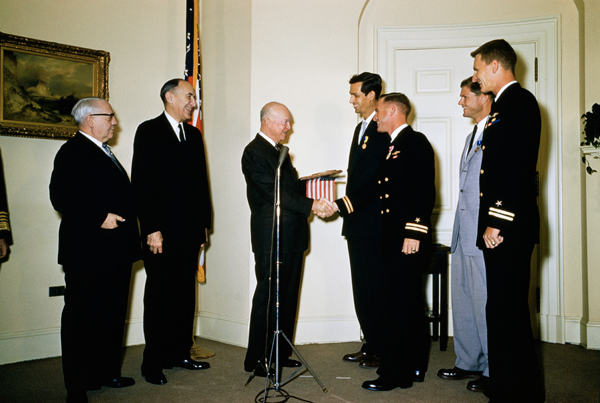
Suddenly I saw, a few yards from the bathyscaph and just behind the crest of a gigantic wave, a tiny black rubber boat loaded with four men—two sailors and two photographers.
Like a centipede in an avalanche of sand, the small boat glided down the flank of a wave and ascended almost vertically toward another crest. With all the speed its little engine could produce, it turned in a circle around us, going up and then down; and in the wind and the salt and the sea I heard the photographers plead: “Salute, do salute, please.”
As ever, photographers!
But, indeed, we saluted gladly; not for posterity, to be sure, not for the photographers, but for the rediscovered sun and pure air, even for the wind and the waves that submerged us each instant. We had only one thought: profound gratitude for the success achieved, gratitude toward all those who had contributed to the success of this uncommon day.
FOOTNOTES:
* NATIONAL GEOGRAPHIC accounts of other descents by bathyscaphe (as the French spell it) include: “Deep Diving by Bathyscaphe off Japan,” January, 1960; “Four Years of Diving to the Bottom of the Sea,” May, 1958; “Two and a Half Miles Down,” July, 1954, all by Lt. Comdr. Georges S. Houot of the French Navy; and “Diving Through an Undersea Avalanche,” April, 1955; and “To the Depths of the Sea by Bathyscaphe,” July, 1954, by Capt. Jacques-Yves Cousteau.
** See “Sailing a Sea of Fire,” by Paul A. Zahl, NATIONAL GEOGRAPHIC, July, 1960.
*** See “Ballooning in the Stratosphere,” by Auguste Piccard, NATIONAL GEOGRAPHIC, March, 1933.



